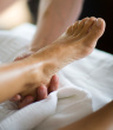Blisters

What are blisters?
Blisters are a small swelling or pocket of fluid in the upper skin layers and is one of the body’s responses to injury, pressure or friction. Under these forces, fluid fills up between layers of the skin to protect the area of pressure and cushion it from further damage. Blisters on the feet are particularly common and can be caused from things such as ill-fitting shoes or friction from increased activity. They are common in runners and athletes, and high heel wearers. The body gradually absorbs the fluid as the underlying skin recovers, or they can often take around a week to burst.
Symptoms
The symptoms of a blister include:
- Reddened and tender skin patch.
- Raised lump filled with clear fluid which may or may not contain blood.
Causes
There are many different causes of blisters in the foot. Some of the most common causes of foot blisters are:
- Forces caused by ill fitting shoes or socks
- Scalds or burns
- Fungal infections of the skin
- Aspartame (diet sweetner) poisoning
- Allergic reaction to irritants
- Heat, moisture and excessive perspiration
Blisters occur when feet get hot, sweaty and socks stick to the feet. The sock and foot then rub against each other and the inside of the shoe, leading to increased friction which causes a blister.
Treatments
Blisters rarely need medical attention, unless they are severe, occur in people at risk of foot problems, are recurrent, are caused by burns or indicative of an underlying infection.
- Resist the temptation to burst the blister or peel off the skin if it has burst. You could cause an infection or hinder your body’s healing process if you unnecessarily burst a blister.
- Keep the area clean and pad it with a soft padding to avoid making it worse and to prevent it from bursting if it hasn't already.
- Zinc cream may help to dry up a blister. However, don’t use zinc cream with a dressing.
- If the blister breaks, it is generally recommended to press gently to remove the fluid and apply an antiseptic (such as iodine) to reduce the risk of infection.
See your Podiatrist, Doctor or other health professional for treatment if:
- you have blisters with red, leaking yellow fluid/ pus or if they are inflamed or if there are red lines near them, as these may be signs of infection.
- If you suspect the blister is caused by some type of skin infection or allergic reaction.
- The blister is caused by burns, scalds or severe sunburn.
Prevention
Some ways to prevent blisters are:
- Wear shoes that fit properly.
- Keep feet as dry as possible. Wearing wet shoes, boots and socks will increase your chance of developing blisters, as wet socks can drag against your skin and lead to blisters of the feet.
- Wear ‘sports socks’ when exercising or playing sports.
If you become aware of a localised ‘hot’ area on your foot, stop your sport and tape the area immediately.
Sometimes toughening up the skin in a certain blister prone area will reduce recurrence. This can be accomplished by applying tincture of benzoin liquid (not the spray; too messy) to the area, let it dry for a minute or so. It will become “tacky”. Then take any dry skin lotion and rub it into the sticky area. Do this on a regular basis and the skin should become hard enough that it will stop blistering. Do not do this while you have an active blister; do this on healed skin. If irritation occurs discontinue use.
Stay smart and you'll be able to avoid blisters on the feet and toes no matter where you are.


